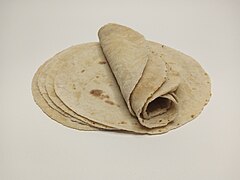Roti
 flat roti, also known as chapati | |
| Alternative names | Ruti |
|---|---|
| Type | Flatbread |
| Place of origin | Indian subcontinent[1][2][3] |
| Created by | Indus Valley civilization[1] |
| Main ingredients | Atta flour |
| Variations | Chapati, Bajra Roti,[4] Jowar Roti, Chawal ki Roti Makki ki roti, Rumali roti, Tandoori roti, Wrap roti, Roti canai, Paratha |
Roti is a type of Indian flatbread made using different flours. It is a staple food in many parts of India and other South Asian countries. Roti can be made from wheat flour, rice flour, millet flour, corn flour, or a combination of these. The dough is kneaded with water and sometimes salt, oil, or ghee. Then it is rolled into thin circles and cooked on a hot griddle or tawa. Roti can be eaten plain or with various accompaniments such as curries, dal, pickles, chutneys, or yogurt. Roti is also known by different names in different regions, such as chapati, phulka, paratha, naan, kulcha, or bhakri.
Variants[change | change source]
-
Roti in the Indian subcontinent
-
Singaporean roti prata served with curry
-
Plain roti paratha
-
A roti wrap with boiled egg and smoked chicken in the Netherlands
-
Indian thali with chapati
-
Tandoori roti served with other dishes in an Indian restaurant
-
A chef preparing rumali roti in India
-
Spicy vegetables served with rotis
-
Roti stuffed with bananas
References[change | change source]
- ↑ 1.0 1.1 Alan Davidson (21 August 2014). The Oxford Companion to Food. OUP Oxford. pp. 692–. ISBN 978-0-19-104072-6.
- ↑ Jim Smith (15 April 2008). Technology of Reduced Additive Foods. John Wiley & Sons. pp. 113–. ISBN 978-1-4051-4795-8.
- ↑ Bruce Kraig; Colleen Taylor Sen (9 September 2013). Street Food Around the World: An Encyclopedia of Food and Culture. ABC-CLIO. pp. 301–. ISBN 978-1-59884-955-4.
- ↑ Aroona Reejhsinghani (June 2004). Feast on a Diabetic Diet. B. Jain Publishers. ISBN 9788180560118.










